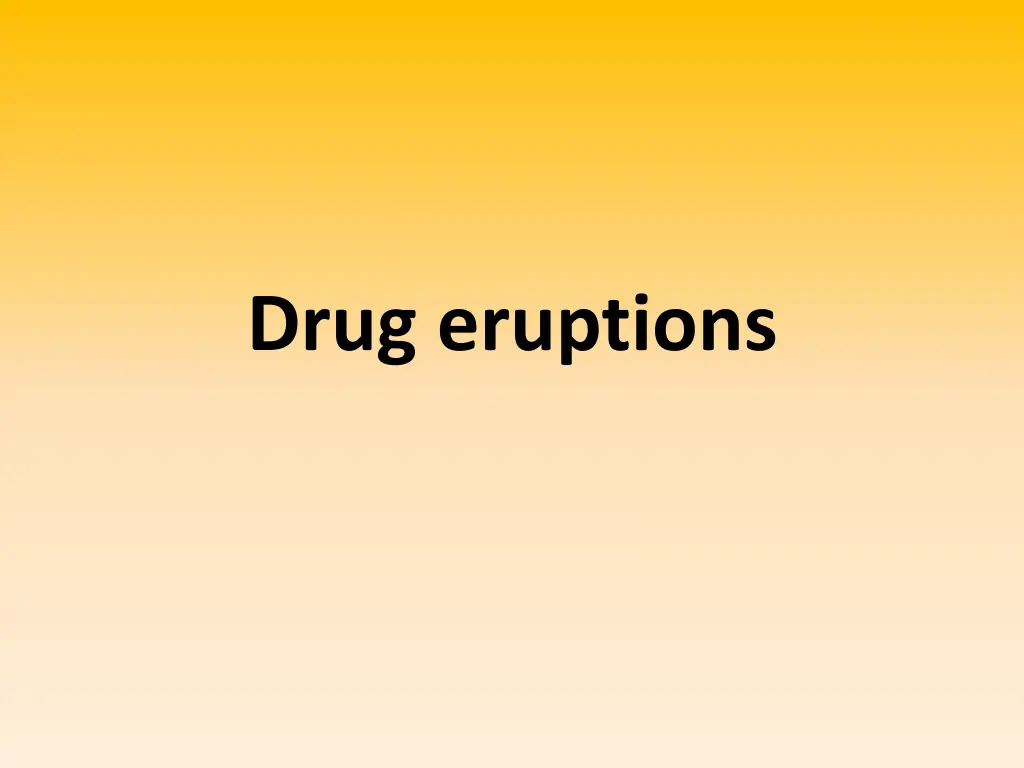
Understanding Drug Eruptions: Symptoms and Clinical Types
Drug eruptions, also known as the great imitator, can mimic various skin diseases and are more common in women and elderly patients. The commonest drugs associated with drug eruptions include anti-microbial drugs, NSAIDs, and drugs acting on the CNS. Clinical types include exanthematous rash, urticarial rash, angio-edema, serum sickness, exfoliative dermatitis, acneform rash, and fixed drug eruption (FDE). Each type presents with specific characteristics, onset times, and associated symptoms, often linked to particular medications. It is important to recognize these reactions promptly for appropriate management.
Download Presentation

Please find below an Image/Link to download the presentation.
The content on the website is provided AS IS for your information and personal use only. It may not be sold, licensed, or shared on other websites without obtaining consent from the author. If you encounter any issues during the download, it is possible that the publisher has removed the file from their server.
You are allowed to download the files provided on this website for personal or commercial use, subject to the condition that they are used lawfully. All files are the property of their respective owners.
The content on the website is provided AS IS for your information and personal use only. It may not be sold, licensed, or shared on other websites without obtaining consent from the author.
E N D
Presentation Transcript
Is also called the great imitator because they can simulate any skin disease, it is more common in women than men, in elderly than young patients. Commonest drugs: - Anti-microbial - NSAIDS - Drugs acting on CNS
Clinical types 1- Exanthematous: it is the most common type , sudden onset of generalized erythematous maculopapular rash, ocurring 1 to 2 wks after drug adminstration, associated with fever & itching, usually last for 1 to 2 wks. Main drugs: penicillin, ampicillin & sulfa drugs
2- Urticarial rash & angio-odema 3- Serum sickness: Type III hypersensitivity reaction. Fever, joint pain, generalized lymphadenopathy sometimes haematuria & urticarial rash started 1 to 3 wks after drug intake. Main drugs: Penicillin & sulfa.
4- Exfoliative dermatitis ( erythroderma): Generalized erythema & scaling involving more than 90% of body surface, it may follow exanthematous rash. Mian drugs: sulfa. Antimalarial topical drugs: tar, sulphur
5- Acneform rash: similar to acne, papules & pustules on the face & trunk but no comedons or scarring i.e monomorphic rash main drugs: topical & systemic C/S anti-TB ( INH)
6- Fixed drug eruption ( FDE) is rash which recur at the same site of skin each time when the same drug is administered i.e called FDE. Clinically the rash started few hrs after drug intake as a well-demarcated oval to round patch or plaque of dusky red erythema & odema & on the top of it there may be a large bullae. It usually healed with post- inflammatory hyperpigmentation
Common sites: - male genitalia - oral mucosa - around eyes & mouth Offending drugs : - sulfa - tetracycline - phenabarbitone
7- eczematous 8- Bullous DE : bullae are usually seen in: a- FDE b- Drug-induced pemphigus : pencillamin captopril c- Erythema multiforme d- photo-toxic reaction
9- Erythema multiforme: main drugs: sulfa, oral CCP 10- Toxic Epidermal Necrolysis (TEN) Is serious condition with high mortality rate. Patient presented with sudden onset of painful erythema started at body flexures & then become generalized. Peeling of the whole epidermis similar to 2nddegree burn associated with fever & toxicity Offending drugs: sulfa, carbamazepine Treat: similar to burn prednisolone 40-60 mg / day
11- Erythema Nodosum (EN) inflammation of subcutaneous fat. Patient presented with painful & tender erythematous nodules on the anterior shins associated with fever & joint pain Commonest drugs: sulfa, CCP
12- Lichenoid eruption: lichen planus like lesions Common drugs: B-blockers , thiazide 13- purpura: thrombocytopenic .. Cytotoxic drugs increased BV fragility .. C/Steroid vasculitis ..carbamazepine
14- Hyperpigmentation: -post-inflammatory like in FDE - increased melanin synthesis . CCP - Deposition of drug material .chloroquine tetracycline 15- hypertrichosis: main drugs: steroid, cyclosporine
16- Hair loss: anagen hair loss cytotoxic drugs telogen hair loss .CCP, thiouracil 17- Pityriasis rosea like: - gold therapy - captopril - mitronidazole
